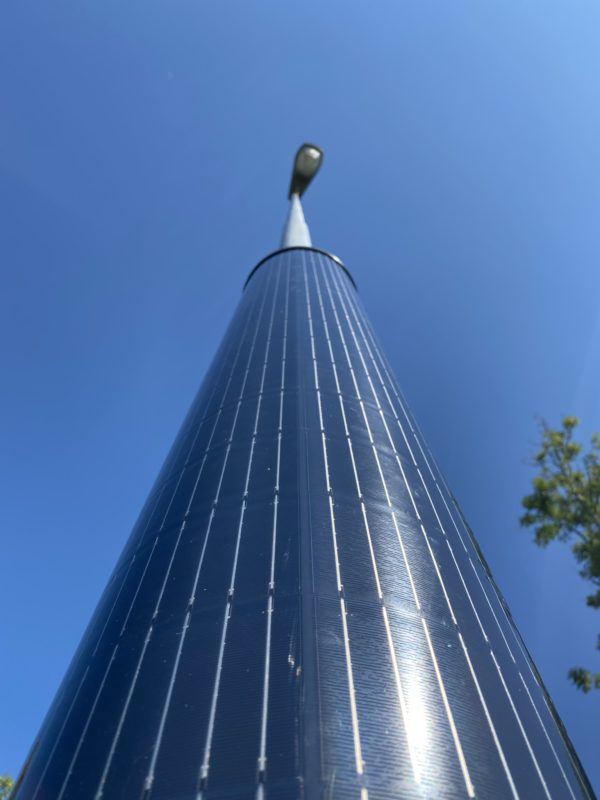Italian start-up Fly Solartech Solutions Srl has developed a lightweight cylindrical solar panel that can be integrated onto PV-powered street lighting lamp posts of different sizes.
The Fly Solartech module is encapsulated in thermoformable plastic technical polymers and relies on a white backsheet. It is available in three versions with a power output of 100, 120, and 240 W.
The most powerful device measures 180 x345 x3.10mm and weighs in at 5 kg. It is built with 84 half-cut monocrystalline cells with an efficiency of 23.4% and has an open-circuit voltage of 12.78 V for each string. The overall efficiency of the 240 W panel is 17.3% and its temperature coefficient is -0.32%.
“The product is divided into two halves which are assembled together to embrace the post,” the company's CEO, Davide Zanatta, told pv magazine. “Each half is composed of two strings of cells that are not interconnected with each other but each with its own junction box.” This configuration allows deploying more cylindrical modules around the same post and connecting them in series and maximizing their output through multi-channel maximum power point tracking (MPPT).

Image: Fly Solartech Solutions Srl
“The thermoformable technical polymers allow shaping the product in its cylindrical shape without incurring internal micro-cracking and maintaining the range of curvature that the cells themselves are is able to absorb,” Zanatta further explained.
The product has a diameter of almost 35 cm including the fixing structures and can be applied on any commercial post with a diameter ranging from 10 to 25 cm. This, according to the manufacturer, also allows for excellent ventilation between the interspace created between the panel and the pole, triggering a natural chimney effect that induces a continuous airflow between the backsheet and the post vertically.
Each cylinder is incorporated in two aluminum fixing collars placed on the external ends of the panel and two lateral guides that allow the perfect closure of the two halves. “Its cylindrical nature allows it to withstand strong winds as well as its vertical application allows limiting to a minimum the deposits of dirt and sand as well as snow accumulation,” Zannatta emphasized.
The product can also be made with an anti-glare protective coating to allow its application on roads and highways where the use of an anti-reflection product is necessary. “The is also easily applicable as a retrofit solution, as it is possible to install the junction box between panel and pole by means of special brackets,” Zanatta concluded.
The product comes with a 10-year product warranty and 20-year performance guarantee.
When asked about the general skepticism around cylindrical PV panels after the bankruptcy of US manufacturer Solyndra in 2011, Zanatta said since then almost everything had changed in the solar market. “One of the weak points of Solyndra was that the panel efficiency was rated at 10-12% and this product was competing on a roof solar market that had better economic and technical options,” he stated. “Our product, instead, is using the latest technologies in terms of efficiency and manufacturing process and it is targeted to fill a very specific demand of the solar market for public lighting, which means the need for panels that do not visually disfigure the environment, that minimizes the need for cleaning them and most important of all that they can be used as a retrofit on poles already installed.”
The panels that are now used for public lighting applications are basically standard panels installed on the pole head, he added. This does not allow them to be installed on existing poles because they need lamps and poles that allow them to be housed at the top of the pole. Moreover, they have higher cleaning costs, and being in a horizontal position tens of meters high, they become easy support for birds and their excretions as they are covered by snow during winter.
Fly Solartech Solutions Srl is based in San Daniele del Friuli, in the northern Italian region of Friuli Venezia-Giulia. It currently owns and operates a 40 MW factory in Tolmezzo, in the same region. “Our plan is to expand the capacity to 100 MW over the next three years,” Zanatta added. The company also develops flexible and lightweight photovoltaic panels, which can be integrated into building envelopes but also in automotive, marine, public lighting, and military applications.
This content is protected by copyright and may not be reused. If you want to cooperate with us and would like to reuse some of our content, please contact: editors@pv-magazine.com.




The cylindrical solar panel seems to be very interesting. Can this also be used around the poles that hold the Wind Turbines? If so, there will be a captive demand for it. Unless, of course, wrapping the pole with panels impede the maintenance activity (if some one has to climb the pole to maintain the turbine and the blades).
From the pictures I deduce that the shape is strictly cylindrical. Will it not have been better for it to the conical in shape so that the sun rays are captured when it is directly overhead especially in tropical regions. The cone may be made narrow at the bottom so that it doesn’t cast too much of a shadow if any other is placed bellow it and it will clean better with rain